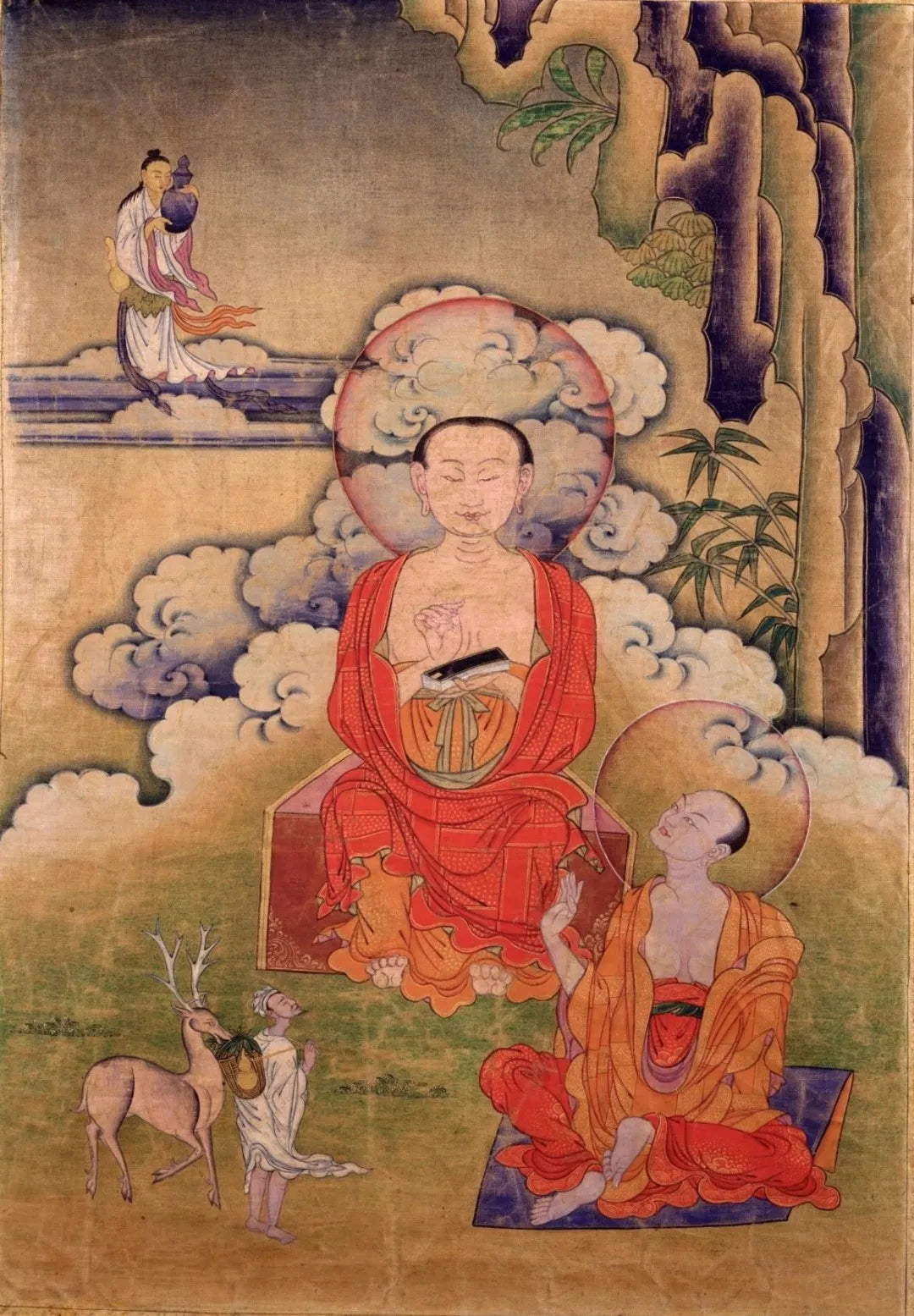
The Tibetan Deer (ཤྭ་བ་): Spirit of the Gods





"The Twelve Danma Goddesses," 19th century, collected at the Jimei Museum.






"Double Deer Dharma Wheel", 16th century, Rubin Museum of Art in New York.
What is a deer?
In the 14th century, the Tibetan Buddhist master and teacher of Tsongkhapa, Ren Da Wa Xunuo Zuozuo (རེད་མདའ་བ་གཞོན་ནུ་བློ་གྲོས་;1349-1412), described gentle and spiritual animals in the Buddhist world in his writings (1375). He wrote: "Horses bring wind and the melodious sound of wind, bodhisattvas wear deer clothing, (...) wrathful deities manifest perfect harmony on donkeys and mules."
Among these, deer, as an important symbol in Buddhist art (at least four stories related to deer in the Jataka Tales), carries cultural significance and metaphors deeply ingrained in the religious art themes of the greater Himalayan region. Whether as background elements in serene Buddha realms, markers of identity for practitioners, or key elements in religious mythology, the graceful animal deer holds rich imagery and meanings in Tibetan art.


In the Tibetan Buddhist world, the deer, symbolizing harmony and gentleness, is referred to as "ཤ་བ་" (sha ba) or "ཤྭ་བ་" (shwa ba) in Tibetan. The two terms have some differences, with the latter being a general term for all animals, including deer, and the former specifically referring to the act of hunting deer and, further, to the deer caught during the hunting process. When referring to a deer, the term used is sha ba, which represents the hunting target, while in ancient Tibetan texts found in Dunhuang, the term shwa ba is more common.
In the early history of Tibet, the deer was one of the six major clans, the "Dong clan" (ལྡོང་ or གདོང་), and this worship of the deer continued in the thirteen "Vima Gods" (ཝེར་མ་) of the indigenous religion. The Vima Gods are both subordinate deities of the main deity and personifications of animal powers (guarding the different abodes that sustain the functioning of the universe). The combination of the 13 Vima Gods is often associated with the protective deity of the Bon religion founder, Tonpa Shenrab, or the warrior god, King Gesar.

"Five Bodies Pure Literature Mirror": Deer Entry




The rescued deer
When it comes to the term "deer, dog, and hunter suffering," we have to mention the religious allegory behind it. You may be familiar with the story of Master མི་་ལ་རལ། (Milarepa, 1040-1123) before he entered the path of Dharma (མི་ལུས་མི་གཙང་བའི་དུས།; impure human body), but in Tibetan art and drama-literature, we usually use the stories that happened during his retreat period (སྒྲུབ་ལ་གནས་པའི་དུས།) to educate the world. Master Milarepa used the method of chanting (མགུར།) to persuade sentient beings to reflect on their own lives and eliminate the source of their suffering. One of these stories took place when Milarepa was meditating in a cave, and the main characters were a mother deer (ཤྭ་མོ།), a hunting dog (ཤ་ཁྱི།), and a hunter (ཁྱི་ར་བ།).
 Illustration of "Milarepa in Meditation": Deer, hunting dog, and hunter,
Illustration of "Milarepa in Meditation": Deer, hunting dog, and hunter,


One day, the master was meditating in a cave when a dark-colored doe with fear in her eyes came running towards him. The master knew that the doe was being chased, so he sang to her in order to help her overcome her fear:
“【...】ཕྱི་སྣང་བའི་ཡུལ་ལ་བྲོས་བྲོས་ནས།འཁྲུལ་སྣང་མ་རིག་པའི་ནང་ནས་ཐར་དུས་མེད།ཕྱི་ལུས་སེམས་སྤངས་ཀྱིས་མི་སྤོངས་ཀྱིས།འཁྲུལ་སྣང་མ་རིག་སྤོང་བའི་དུས་ལ་བབ།【...】འབྲོས་ན་ནང་གི་སེམས་ཉིད་བྲོས།སེམས་ཉིད་བྱང་ཆུབ་གནས་སུ་བྲོས།གཞན་བྲོས་པས་ཐར་འདོད་འཁྲུལ་པ་ཡིན།སེམས་འཁྲུལ་པ་བཤིག་ལ་འདི་རུ་སྡོད།【…】”
"【...】Feeling the world escaping, unable to break free from the ignorant realm; Let go of mundane body and mind, ignorance and illusions will depart【...】Escape and the mind intelligence will follow, escape to the sacred realm of enlightenment; Escape the desires of external objects, if startled by the illusions of the mind, remain here【...】."
After he finished singing, the doe's heart instantly became calm and peaceful. She lay down next to the master, licking his robe. Why would a deer, symbolizing practitioners, also experience suffering within the confines of established religious narratives? According to the 8th Karmapa Mikyo Dorje (མི་བསྐྱོད་རྡོ་རྗེ་;1507-1554), "practitioners themselves are vessels for enduring the restless and unsettled mind." It appears that the recipients of Milarepa's teachings in this story have a strong sense of inclusivity, both in his perspective and in self-reflection.



"【...】What illusion makes you angry?
The hatred in your heart brings confusion;
Born as an evil dog,
Enduring the pain of hunger,
Suffering from constant mental torment;
If you do not guard your own wisdom,
What use is there in guarding the ordinary bodies of others?
Better to control your own desires,
Quickly remove the resentment from your heart【...】".
After singing, the hunting dog stopped barking furiously and lay down meekly by the master's side. With a deer on one side and a dog on the other, they guarded the master like mother and child. Compared to animals, human desires are even more complex. The conversation that followed between the master and the hunter Gongbu Doji became a model for future teachings.



I believe any hunter, upon seeing their prey and hunting dog get along so well, would show a surprised expression. The hunter explained to the master that his profession was simply for sustenance, he did not have lofty ambitions, and he did not need to shoulder the responsibility of saving all living beings like the master. In response to the hunter's words, the master sang slowly:
“【...】མི་ལུས་རིན་ཆེན་དཀོན་གསུངས་ཏེ།ཁྱེད་འདྲ་མཐོང་ན་དཀོན་རྒྱུ་མེད།སྲིན་པོའི་གཟུགས་ཀྱི་སྡིག་པ་ཅན།ངན་སོང་སྡུག་བསྔལ་ཁྱད་བསད་ནས།ཚེ་འདིའི་འདོད་པ་སྒྲུབ་ལགས་ཀྱང།སྡིག་པས་འདོད་པ་མི་འགྲུབ་སྟེ།【...】ཁྱོད་ཤྭ་བ་བསད་པས་མི་འགྲངས་ཏེ།ནང་དུག་ལྔ་བསད་ན་ཅི་བསམ་འགྲུབ།ཕྱི་དགྲ་བོ་བཏུལ་ཡང་ཇེ་མང་འགྲོ། ནང་རང་རྒྱུད་བཏུལ་ན་དགྲ་བོ་མེད།【...】”
"【...】All say it is noble to be reborn as a human, yet you as humans are not worthy; those with the bodies of ghosts and demons bear the sins, you disdain the suffering of karma, seemingly achieving desires in this life, in reality clinging to desires with no end in sight. 【...】Killing deer to satisfy hunger temporarily is enough, eradicating the five poisons of karma to achieve true liberation; slaughtering external enemies endlessly, overcoming the inner enemy will ultimately lead to no harm.【...】"


After the song, the hunter's mind began to reflect, but he still felt curious about the master's way of life and vision. When he saw the simple living conditions in the cave, and heard the master calmly recounting the joys and hardships of his practice throughout the four seasons, as well as his unwavering faith in the right path, the hunter was filled with immense admiration for the master. He offered the deer, the hunting dog, and his bow and arrows as offerings to the master, and vowed to spend his life practicing and eradicating his sins.
Of course, you can see this story as a literary expression of philosophical concepts. But whenever we read the stories of the ancient philosophers, we still marvel at their "universal resonance" with life. Through the art of chanting, the masters transformed ethical commands into aesthetic narratives, and people have always been followers of beauty in order to combat the illusions of this world.

Deer as a symbol
In Buddhist imagery, the most important representation of deer is the "Pair of Deer Turning the Wheel of Dharma," with the male deer on the right and the female deer on the left. This image is related to the historical event of the Buddha giving his first teaching at Deer Park, known as the "First Turning of the Wheel of Dharma." However, according to scholars of Indian religious and cultural history, the pattern of the paired deer has already existed in the Shaiva tradition.
In the religious traditions of South Asia, there is a phenomenon of shared religious spaces among different sects, so it is difficult to say that Deer Park belongs exclusively to the Buddhist system. In earlier texts, such as the Shiva Purana, deer symbolize a fixed, otherworldly place of practice, which aligns with the Shaiva tradition of Nava Shasana. They require the image of deer to enhance the sacredness of their practice space.

In the classic Tibetan art composition, the "Six Longevity Symbols" (ཚེ་རིང་རྣམ་དྲུག་), the symbol of the deer combines the artistic meanings from East Asia, South Asia, and the Himalayan region. We have no way to prove that this image has a fixed origin, as it seems to be a blend of various styles and cultural backgrounds. It can be seen simply as a beautiful symbol with positive connotations, or one can find more specific religious meanings in the text.


The story can take place in a mountain forest in East Asia or a tree forest in South Asia, but there is a specific name for this space: the Great Bliss Forest (སྐྱིད་ཚལ་ཆེན་པོ་). The mountain resembles a spiraling conch shell, it is the diamond mountain blessed by Buddha and the sacred place of Amitabha Buddha. The mountain flows with spring water possessing eight special qualities. Living here is a long-lived immortal leaning against a thousand-year-old pine tree, who is unaffected by the influence of the five elements due to a thousand years of cultivation.
The image of the long-lived old man is widely present in various Asian regions. This includes the ancient Chinese divine Nanji Laojun, the long-lived elders of South Asia, and the old man gods of northern Asian peoples and the ancestors of the Naxi people. There are also symbolically long-lived deer and immortal cranes accompanying a group of animals by the side of the immortal.
According to a structured religious interpretation, the old man represents knowledge and immortality, the rock represents determination and blessings, the spring water represents diligence and nectar, the tree represents self-discipline and liberation from reincarnation, the bird represents generosity and a peaceful heart, and the deer represents patience and practice. What an interesting and aesthetically pleasing combination.

The sacred cannot do without deer.
Because deer often live in groups and coexist with sages, they always maintain compassion and empathy, so various types of bodhisattvas are commonly seen wearing deer skin robes (krishnasara; sometimes also gazelle skin). The practitioner with the closest relationship to deer is Shavaripa, one of the 84 Mahasiddhas (great accomplished ones).






On the second day, Guanyin Bodhisattva used her divine power to transform into a group of deer, easily fulfilling her promise of shooting a hundred deer. Savaripa was extremely impressed and asked the Bodhisattva to grant him the skill of hunting. Guanyin Bodhisattva agreed, but she asked Shawarjab and his wife not to eat meat for a month. Shawarjab agreed to this request in order to become the most skilled hunter.


The Bodhisattva then began to teach them the Vajrayana teachings and helped Savaripa and his wife overcome their ego and pride. After twelve years of rigorous practice, Shavari finally attained the accomplishment of the Great Seal, and became a model for practitioners in the Kagyu lineage in the Tibetan region.


Compared to the complexity of interpretation in religions such as tigers and elephants, the image interpretation of deer is simple and clear. However, it is this uniformity that gives deer a unique status in Buddhist art. From the Buddha to bodhisattvas, from practitioners to Buddhist masters, deer have always humbly listened to the transient yet eternal Dharma.
.
Dancer wearing a deer mask. Kirimtse Monastery, Chumbi Valley, Tibet 1930.






